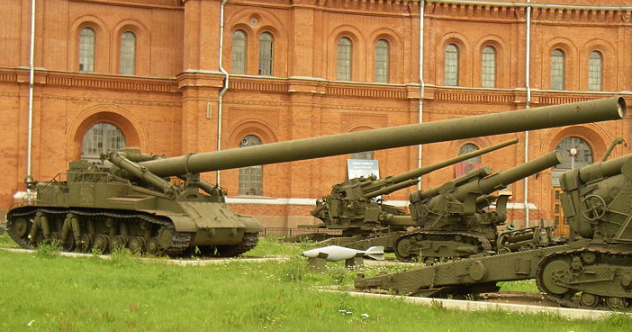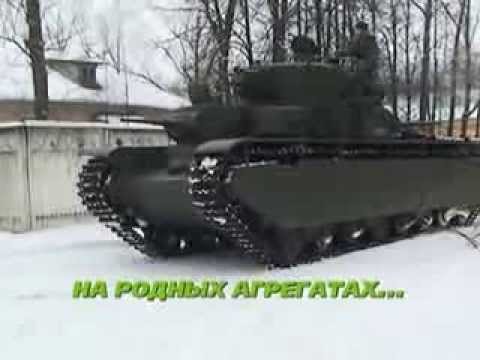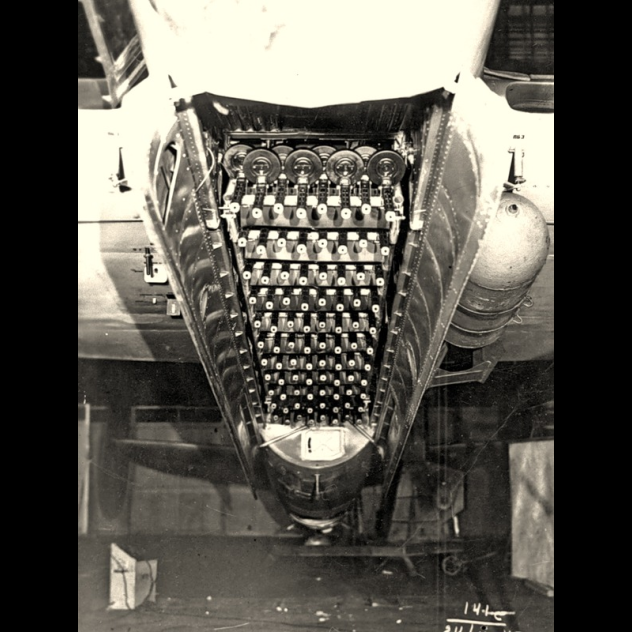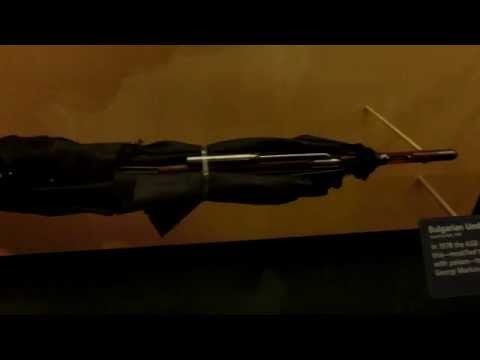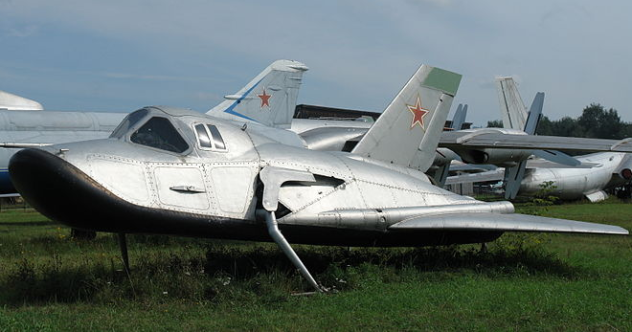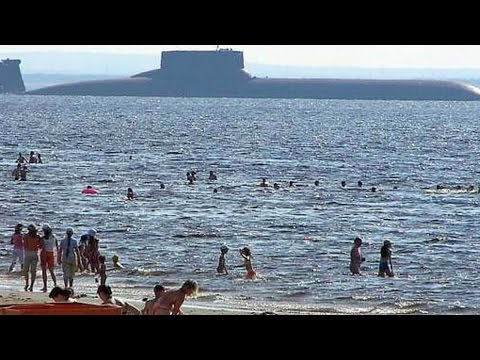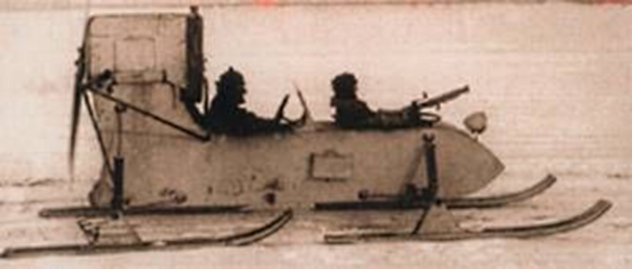10 VVA-14
Nuclear submarines were a key part of Cold War strategy for both the Soviet Union and the United States. Due to the damage that submarines could do during a nuclear war, both sides developed complex countermeasures for detecting and destroying them. One of the best ways to destroy submarines was by using specially designed anti-submarine warfare (ASW) aircraft fitted with a variety of torpedoes and sonar systems. Of all the ASW aircraft from the Cold War, none were stranger than the Soviet Union’s VVA-14. When the Soviets caught wind of new US submarines designed to carry Polaris missiles, they quickly scrambled to design a new airplane to counter them. Turning to famous floatplane manufacturer Beriev and Italian expatriate engineer Robert Bartini, Soviet commanders began to work on the new ASW aircraft. The VVA-14 would take off vertically from the water using a system of 12 turbofan engines, making it one of the only amphibious vertical takeoff airplanes ever. Once airborne, the VVA-14 would be able to make high-speed flights at high altitudes. It was also capable of using the ground effect for speedy, low-altitude attack runs. To do so, the VVA-14 would fly only a few meters above the water on the cushion of air between the surface and the airplane. All of these features ended up giving the VVA-14 an unusual and ugly look. Despite its odd appearance, the plane flew relatively well and was state-of-the-art for Soviet aviation. Had it entered service, the VVA-14 would have carried computerized ASW equipment and top-of-the-line sonar. Two years of testing went by as Beriev and Bartini perfected the airplane. However, when Bartini died in 1974, the project slowed down considerably and eventually halted altogether. Soviet commanders became disenchanted with the complex airplane and settled for more conventional ASW aircraft. The prototypes were dismantled and destroyed. The only surviving copy is missing its wings and engines. It resides in a flight museum outside Moscow.
9 Lipstick Gun
One of the most recognizable aspects of the Cold War were the spies of both sides. Each side had a variety of fascinating gadgets that operatives used, and some of the most interesting come from the Soviet Union. Historians are not aware of all the weapons used by Soviet agents, since the only ones that we know about were confiscated during border crossings or from captured agents. One of the most fascinating is the Soviet lipstick gun, known as the “Kiss of Death.” Only one example of the Kiss of Death exists. Guards confiscated it during a border crossing between East and West Germany in 1965, and analysts assumed that the gun was standard issue for female spies. Used as a last-ditch weapon, the Kiss of Death looked like a metal lipstick container and carried a single 4.5-millimeter bullet. Reloading the weapon would have been impossible, so operatives would have used it only if necessary. It is not known how widely carried the gun was, but it presents a fascinating glimpse into the secret life of Soviet spies.
8 2B1 Oka
The atomic bomb was the main weapon of the Cold War, and both sides invented many strange ways to deliver the devastating weapon in times of war. Before guided nuclear missiles reached maturity, nations relied on unguided delivery systems. Both sides invested in and developed nuclear artillery pieces for battlefield delivery. However, it was the Soviets who really ran with the idea and created one of the biggest artillery guns ever developed, the 420-millimeter 2B1 Oka. To give an idea of how big a 420-millimeter cannon is, the main battery of an American Iowa-class battleship was 406 millimeters, so the Oka was a bit larger than a battleship cannon. The big cannon was able to fire a 750-kilogram (1,650 lb) projectile at a range of up to 45 kilometers (28 mi). Such a big gun had a gigantic recoil, which was one of the Oka’s biggest failings. Firing the cannon effectively destroyed the self-propelled chassis. Even if the gun could have fired multiple times, its huge projectiles would have cut down the firing time, even with a crew of seven people. Although it started life as a nuclear cannon, in practice, the Oka would mainly launch conventional projectiles and use its nuclear capability only when necessary. With all the Oka’s drawbacks, the Soviet military decided against further development of oversize artillery pieces. Instead, they focused on guided missiles that would have a longer range than any projectile-based weapon. Large artillery guns fell out of favor, and the Oka became a footnote in Cold War history.
7 T-35 Heavy Tank
In the lead-up to World War II, the world powers invested in a variety of interesting combat systems, including the vogue super-heavy tank. First proposed by the British and called “landships,” super-heavy tanks were meant to be indestructible mobile fortresses in an armored campaign. Dozens of designs were investigated by industrialized countries, but few ever went into production. Soviet tank engineers loved the idea of super-heavy tanks and designed a few of their own. Of all the concepts, the one that saw the most use was the T-35 heavy tank. The T-35 was originally based on a British design that was adapted by Soviet engineers. The hallmark of the T-35 was its five turrets, which could fire in all directions. The primary turret was a standard main tank cannon, while the other four turrets housed a combination of smaller cannons and machine guns. Although the tank was huge on the outside, it was extremely cramped on the inside. Because it was so heavy, the T-35 could only reach a top speed of around 30 kilometers per hour (20 mph), which was slow by prewar tank standards. Despite all its armament, the T-35 was lightly armored for its weight class. These two limitations meant that the T-35 was outdated by the time that deliveries to tank units began. When the Nazis invaded the Soviet Union, every tank fought on the front line. T-35s became static defensive positions, taking advantage of their formidable armament while minimizing their mobility weakness. Combat experience soon showed that the T-35 was far too big a target for the faster German tanks. However, enemy fire was not the biggest worry for T-35 crews. Mechanical failure, especially in the drivetrain, accounted for 90 percent of the T-35’s combat loses. Within the opening months of the war, the T-35 was off the front line. One still survives today in a Russian museum, showcasing the only production example of a five-turreted tank.
6 Tu-2Sh Fire Hedgehog
With World War II grinding on into 1944, the Soviet Union became increasingly anxious to win the war as soon as possible. To do this, they began to experiment with a variety of unusual weapon systems that would give them more of an advantage over German forces. Since the war was turning in their favor, Soviet engineers were given more freedom and time to experiment with weapon systems. Key among these were modifications to the highly effective Tu-2 bomber. Engineers fitted it with a giant 75-millimeter cannon at one point, but the weirdest modification was the Fire Hedgehog gun emplacement. Designed as an anti-infantry weapon, the Fire Hedgehog was an array of 88 PPsH infantry submachine guns that was fitted in the Tu-2’s bomb bay. The guns were placed at an angle that was optimized for shooting at the ground. In combat, the pilot was supposed to fly low over infantry positions and fire the set of 88 guns into the ground, creating a hellish storm of bullets. Able to fire 72,900 rounds per minute, the Tu-2Sh could fire 6,000 rounds onto a 550-meter-long (1,800 ft) piece of land during a four-second attack run. Fortunately for the Germans, the Fire Hedgehog never saw service. Few documents about the Fire Hedgehog survived World War II, aside from pictures of the test plane, which show how crazy this weapon was. To this day, the Tu-2Sh Fire Hedgehog holds the record for the most guns placed on an airplane, a record which will not be beaten any time soon.
5 Poison-Shooting Umbrella
Another Soviet spy weapon, the poison-shooting umbrella was actually used for operational missions and received the nickname “Bulgarian umbrella.” The weapon looked like an umbrella on the outside, but the tip of the umbrella was a sharp injector for stabbing. When the target was stabbed, a pneumatic mechanism shot a small ricin pellet into the body, killing the target within a short time. Easily concealable, the Bulgarian umbrella was the perfect assassination weapon. The most notorious use of the weapon was the assassination of Bulgarian writer Georgi Markov in London. Markov had left the Soviet Union and was a known dissident. The Bulgarian secret police and the KGB teamed up to orchestrate the assassination in September 1978 on the Waterloo Bridge. An agent stabbed Markov in the leg. The writer died of ricin poisoning three days later. Although no other known cases of the weapon being used exist, it was rumored to have been a favorite weapon of the Bulgarian secret police and the KGB.
4 MiG-105
Space planes are all the rage now, given the success of Virgin Galactic and other space companies. Although the idea of space planes has become more popular in modern times, during the Cold War, both sides experimented with them in an attempt to militarize space. The United States tested the X-20 Dynasoar, while the Russians conducted their own tests in response with the odd-looking MiG-105. Nicknamed “Lapot” (a slang word for “shoe”) because of its distinct appearance, the MiG-105 was the proof-of-concept vehicle for a whole series of Soviet space planes under the Spiral project. Spiral space fighter planes were intended to ensure complete control over space and block any NATO incursions out of the atmosphere. They would have taken off on top of a traditional solid rocket booster, complete their mission, and return to a base. The MiG-105 was an atmospheric test vehicle meant to determine the feasibility of a manned-reentry space plane. It was never intended to actually fly into space but rather to provide valuable lessons for the next phase of Spiral space planes. The MiG-105 was successful in its flights, making a variety of powered hops from Moscow airstrips. However, by the late 1960s, Soviet commanders questioned whether a military space plane program was feasible. When it came down to numbers, space planes were too expensive for granting insignificant strategic advantages. The program ended in 1969. However, the MiG-105 reentered service in 1974 in response to NASA’s space shuttle program. The new round of tests were mostly for propaganda purposes, and Soviet commanders were still unenthusiastic about Spiral. After four years of sporadic flights, the MiG-105 was finally grounded for good, and focus shifted to the Buran space shuttle program. The MiG-105 test vehicle resides at the Monino air museum as an odd reminder of the closest that a country has come to making a starfighter.
3 Akula Submarine
Russia is known for building the biggest things. One of its lesser-known records is building the biggest submarine that the world has ever seen. Soviet engineers produced the Akula–class (also called “Typhoon”) near the end of the Cold War, right before the dissolution of the Soviet Union. They originally designed the Akula to carry as many missiles as the US Ohio-class submarine. However, Soviet missiles were bigger than their American counterparts, and as such, the Akula concepts ended up being larger than the Ohio class. Once it reached production, the Akula was even larger than its original concept designs, at 175 meters (574 ft) long and 23 meters (75 ft) wide. The Akula was a beast of a submarine. It was intended to complete missions under the polar ice cap and had to sustain the crew effectively through long, multi-month missions. Engineers decided to use the odd technique of fitting the submarine with multiple pressure hulls. For most submarines, there is an outer hull and then a strong pressure hull just inside that runs the length of the ship. The Akula had five pressure hulls—two main crew hulls, one smaller hull near the top of the ship, and two other small hulls for torpedo and maintenance of the two nuclear reactors. This design gave the Akula its huge dimensions and also made the crew more comfortable while increasing survivability. It also meant that the Akula was essentially five submarines melded into one. Although designed primarily as a missile submarine with 192 warheads, the Akula also carried six torpedo tubes for engaging other submarines. Fortunately, the Akula never saw combat, and the end of the Cold War reduced the need for the subs. As they reached the end of their working lives, the Akula submarines were scrapped instead of modernized, with Canada and the United States providing 80 percent of the funds to destroy the subs. The Russian Navy replaced the Akula with a smaller submarine, ensuring that it still holds the record for biggest submarine ever and is one of the few submarines to use a multiple pressure hull configuration.
2 Sukhoi T-4
Every nation in the Cold War invested in large heavy bomber aircraft. Especially in the 1960s, nuclear strategy revolved around long-distance, high-altitude bombers interdicting enemy airspace to drop nuclear weapons. In the early 1960s, the United States began work on the XB-70 Valkyrie, a huge Mach-3 bomber plane that was designed to be impossible to shoot down. Fearing a US bomber lead, the Soviets began developing their own Mach-3 bomber, the Sukhoi T-4. Both the T-4 and the XB-70 had similar design features and were the pinnacle of bomber technology at the time. The T-4 was smaller than the XB-70 but shared a similar delta-wing configuration with a bank of engines underneath the fuselage. The airframe was made almost completely out of titanium and stainless steel and had an innovative quadruple-redundant fly-by-wire system. To give ideal high-Mach performance, the airplane did not have an exposed cockpit section. While on the ground and during takeoff, the nose drooped down to expose a forward-facing windshield. When the T-4 reached altitude, the nose raised and covered the windshield. With the nose raised, the pilot had to fly via a periscope that would stick out of the fuselage. Once the bomber reached Mach velocities, the periscope lowered, and the pilot flew by instruments and little windows on the side of the cockpit. Originally, the T-4 was designed as a nuclear bomber, but it later picked up a secondary reconnaissance role. Oddly, the surviving prototype, at the Monino air museum outside of Moscow, lists the T-4 as an anti-shipping bomber. Whatever the case, the T-4 fell out of favor with Soviet commanders before testing was even completed. With the new breed of NATO surface-to-air missiles, the T-4 could have easily been shot down, even at Mach 3. Compounding this operational limitation was the enormous cost of the bomber. Soviet strategy focused more on light fighter-bomber aircraft like the MiG-23. These fighter-bombers had nuclear capability, which negated the usefulness of the T-4. The project ground to a halt a few years after the comparable American XB-70 stopped testing.
1 Aerosani
Whenever people think of Russia or the Soviet Union, they typically think of cold, long winters. Most of Russia’s winters are indeed long and harsh. Because of this, the Soviet Union had a variety of vehicles specifically designed to fight in the cold during World War II. Some of the most interesting and oddly effective vehicles were the Aerosani. They were essentially sled tanks. (An RF-8 is pictured above.) Designed to carry two crew members and a few guns, the Aerosani were light sled vehicles with an airplane motor mounted on the back, driving a propeller. The engine would give the Aerosani forward thrust, allowing it to quickly traverse the frozen tundra of Northern Europe. The most common and successful Aerosan was the NKL-26. The sled had light armor and was powered by a five-cylinder aircraft engine. NKL-26 detachments were used to great effectiveness in the Winter War against Finland. Units were mostly responsible for communication and logistic work, but they could fight if needed, using a mounted light machine gun. Because of their great mobility on snow, NKL-26s made effective surprise attack vehicles. When the Nazis invaded, Russian Aerosan units were pressed into front-line duty from 1942–43. As the war progressed, the need for the Aerosani became less pronounced, and they eventually fell out of favor. After the war, Soviet commanders saw no need to upgrade the Aerosan vehicles, so the whole idea was dropped. The NKL-26 and its siblings remain a strange footnote in Russian winter military operations. I am a physics major who lived in Russia for a while. I am very interested in military history, especially Russian and Soviet military history. Check out my personal blog and other articles on this site.


